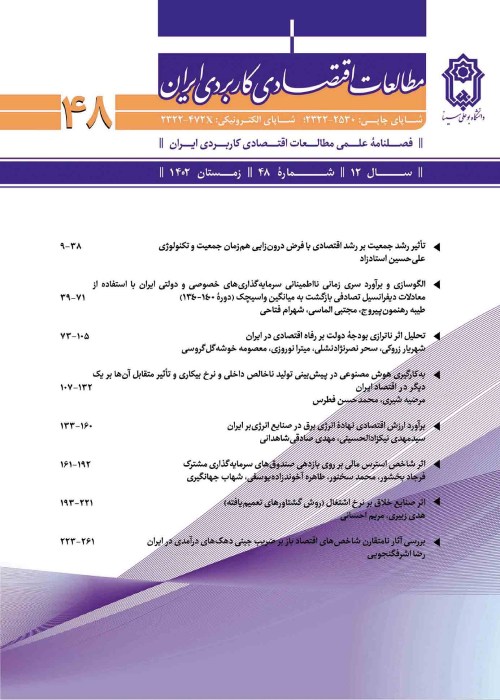The Investigation of the role of Monetary Policy and Financial Leverage on Financial Stability in the Economy of Iran
Author(s):
Article Type:
Research/Original Article (دارای رتبه معتبر)
Abstract:
Policy rate and macroprudential tool are two of the main policy tools that affect the financial situation of the economy. While the policy rate is well-known monetary policy tool among most central bankers to achieve price stability and output stability in the economy, macroprudential measures have resurged recently and are becoming an increasingly active instrument. The main advantage of having two sets of policy tools is that they can target different policy objectives. In empirical studies, the effectiveness of a macroprudential measure is measured through its effect on procyclicality of financial risks (the correlation between GDP growth and financial risk variables such as credit growth and financial leverage), or through the level of financial risk (for example, the level of Credit growth and financial leverage). In this study, following Bailliu and et.al (2015), we define macroprudential policy as a policy that uses primarily prudential tools to limit systemic financial risk. For this purpose, credit growth is used as a substitute for financial instability. Also, we focus on the leverage index as a precautionary tool to deal with excessive credit growth. Although there seems to be a broad consensus on the central role of macroprudential policy measures in containing financial instability build-ups (IMF, 2014a), there are different views on the role of monetary policy in this matter. Smets, (2014) distinguishes between the three main views. The first view is that monetary policy should only focus on traditional objectives, such as inflation and real economic activity. In the second view, financial stability is at least as important as traditional objectives, and that decisions regarding the setting of policy interest rates should equally consider financial stability concerns. The third view, which is increasingly gaining consensus in the aftermath of the Global Financial Crisis, acknowledges that in some circumstances, monetary policy may deviate from its traditional objective in order to support financial stability, if costs from doing so are smaller than benefits (IMF, 2015b). Hence, in this study, in addition to examining the role of monetary policy in achieving the common goals of the policy of stability of inflation and the stability of output in the economy, we examined its role as well as the role of financial leverage in improving the financial stability of Iran through controlling the growth rate of bank credits. For this purpose, first, using the Markov switching model, we estimated the policy rule in which the rate of base money growth is adjusted in response to the inflation gap and the output gap. The results showed that the central bank has been more seeking to achieve the goal of economic stability through the application of expansionary monetary policy; so that achieving this goal has a higher stability and durability than the goal of inflation stability during the studied period in the Iranian economy. Then, the policy rule is estimated in which the growth rate of credit to private sector (as a measure of financial stability) is adjusted in response to monetary policy shocks and financial leverage (the ratio of private sector debt to output). The results showed that the financial leverage index has not been used as a precautionary measure for tackling systematic risk and achieving financial stability during the years under study; In spite of worsening the status of entrepreneur's balance sheets by increasing private sector debt, credits growth to various sectors of the economy have also increased. Nevertheless, the results are indicated the proper performance of monetary policy in improving financial stability by controlling the growth rate of credits. So that, the monetary policymaker, through controlling excessive credit expansion, reduces the risk and probability of a default on loans by entrepreneurs and thus has led to improved financial stability of the economy.
Keywords:
Language:
Persian
Published:
Quarterly Journal of Applied Economics Studiesin Iran, Volume:6 Issue: 24, 2017
Pages:
75 to 94
magiran.com/p1776422
دانلود و مطالعه متن این مقاله با یکی از روشهای زیر امکان پذیر است:
اشتراک شخصی
با عضویت و پرداخت آنلاین حق اشتراک یکساله به مبلغ 1,390,000ريال میتوانید 70 عنوان مطلب دانلود کنید!
اشتراک سازمانی
به کتابخانه دانشگاه یا محل کار خود پیشنهاد کنید تا اشتراک سازمانی این پایگاه را برای دسترسی نامحدود همه کاربران به متن مطالب تهیه نمایند!
توجه!
- حق عضویت دریافتی صرف حمایت از نشریات عضو و نگهداری، تکمیل و توسعه مگیران میشود.
- پرداخت حق اشتراک و دانلود مقالات اجازه بازنشر آن در سایر رسانههای چاپی و دیجیتال را به کاربر نمیدهد.
In order to view content subscription is required
Personal subscription
Subscribe magiran.com for 70 € euros via PayPal and download 70 articles during a year.
Organization subscription
Please contact us to subscribe your university or library for unlimited access!



